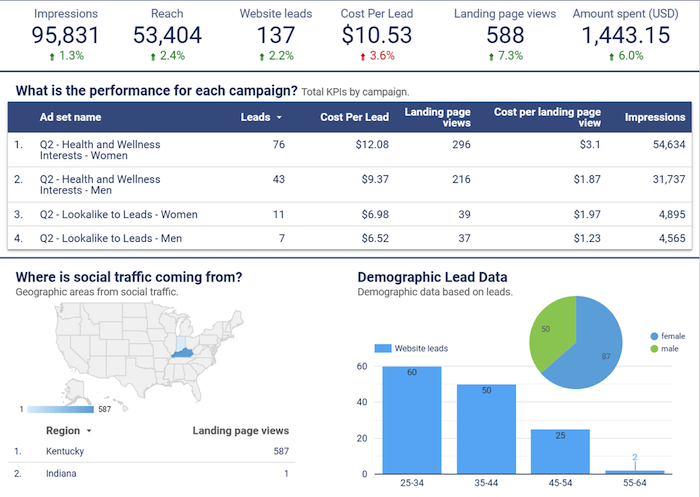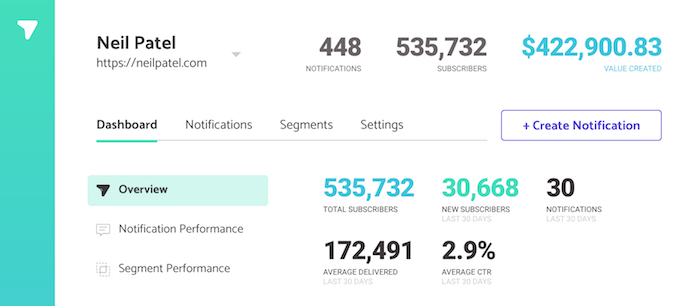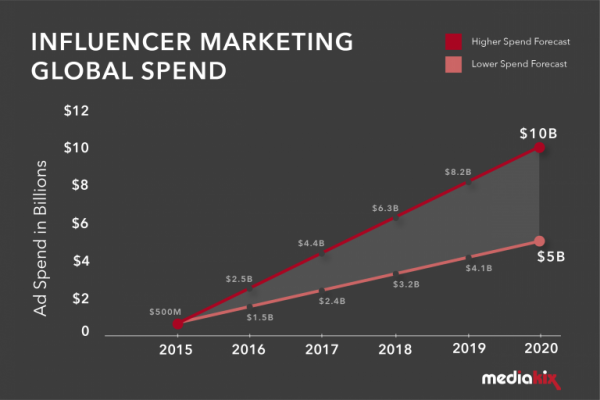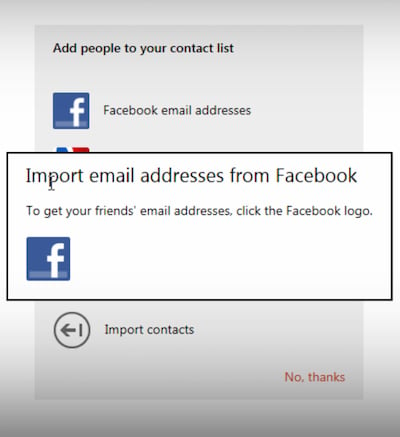MARKETING
Marketing Trends for 2020: Here’s What Will Happen That Nobody is Talking About

The new year is right around the corner. And I know you are already prepared because you read this blog and tons of other marketing blogs, right?
But here is the thing: I also read most of the popular marketing blogs, follow all of the marketing YouTube channels, and listen to the same podcasts you do.
And I’ve noticed that very few people are talking about what’s really going to happen in 2020.
Sure, they will tell you things like voice search is going to account for over 50% of the search queries next year but all of that stuff has already been talked about.
And there are actually more interesting trends that will affect your marketing that no one is really talking about.
So, what are these trends? What’s going to happen in 2020?
Alright, here goes…
Trend #1: Companies who rely on Google Analytics will get beat by their competition
We all love Google Analytics.
Heck, I love it so much I log in at least 3 or 4 times a day. And here is the kicker: I get so much traffic that my Google Analytics only updates once a day.
I really need to break that habit but that’s for another day.
You are probably wondering, what’s wrong with Google Analytics?
There actually isn’t much wrong with it. It’s a great tool, especially considering that it’s free.
But here is the thing… marketing has been changing. New channels are being constantly introduced, such as voice search.
And transactions no longer are as simple as someone coming and buying from you and that’s it.
These days there are things like upsells, down sells, repeat purchases, and even checkout bumps. On top of that, there are so many different ways you can generate revenue for your online business, such as partnerships, affiliate marketing, and even webinars.
This has caused companies to start using analytics solutions that tie into their database better, such as Amplitude. Or better yet, you are seeing a big push into business intelligence.
A central place where you can tie in all of your data and make better-informed decisions so you can optimize for your lifetime value instead of your short-term income.
In 2020, you will see more companies adopting business intelligence solutions… from paid ones to free ones like Google Data Studio.

If you haven’t checked out Data Studio, you’ll want to start now because it is easy to pass in all of your business and marketing data into one place. For example, you can pass in more granular data from your Facebook ad campaigns into Data Studio while that would be a bit difficult to do with Google Analytics.
Trend #2: Companies will optimize for voice search, but not for revenue
According to ComScore, over 50% of the searches in 2020 will be from voice search. But that’s not really a new trend… everyone has been talking about that for years.
So, what’s the big deal?
Optimizing for voice search is a great way to get your brand out more, but how is that going to convert into sales?
I haven’t seen too many solutions so far when it comes to capitalizing on your voice search traffic, but so far there is Jetson.ai.
If you aren’t familiar with Jetson.ai, it makes it so people can buy from your site using voice search. It doesn’t matter if it is Alexa or Google Home, they work with most of the popular devices.
For example, if I keep ordering the same toothpaste from a specific store using voice search, Jetson.ai keeps track of that so you can easily keep ordering the same product over and over again with little to no friction.
Heck, it’s easier than logging into your computer or pulling out your phone to make a purchase.
Trend #3: Your lists won’t convert as well, so you’ll have to look for alternative communication channels
Email, it’s something we all use in the corporate world.
But here is something interesting when it comes to marketing emails… I’m in a group with a bit over 109 email marketers across different industries in different parts of the world.
And can you guess what we are all noticing?
Our open rates are staying roughly the same and that’s largely because we all know how to clean and optimizing for deliverability.
But our click rates are going down.
So far as a group we have seen our click rates drop by 9.4% in 2019.
That’s crazy considering as a group we have over 146 million email addresses.
Now does this mean email is dead?
Of course not!!!
Email is here to stay and will be here for a very long time.
But what companies will have to do in 2020 is to leverage more communication channels.
Chatbots will take off drastically. Not necessarily the Intercom’s or Drift’s of the world but more so the solutions like ManyChat and MobileMonkey.
ManyChat and MobileMonkey leverage Facebook Messenger and as they connect it with Instagram and WhatsApp it will get even more popular.
In addition to chatbots, you’ll see more people leveraging tools that allow push notifications like Subscribers.
It’s so powerful, here is the impact I’ve been able to generate from push notifications so far using Subscribers.

You can wait till next year to lever chatbots and push notifications, but I’d recommend you start sooner than later. 😉
Trend #4: Moats will almost be non-existent, other than brands
You’ve probably heard the word “moat” before. If you haven’t, just think about water around a castle.

Back in the day, they had water all around the castle and they used a drawbridge to get in and out of the castle, so it would protect them from invaders.
With your business, you may have a moat. It could be a feature, your cost structure, a technological advantage, or even a marketing advantage.
Over the years, moats in the online world have slowly been disappearing.
It’s easy for anyone to copy these days. So, what’s separating you from your competition?
Something could work right now, but it won’t last forever…
But do you know what will still be a strong moat in 2020 and even a stronger one in the future?
It’s branding.
People buy Jordan shoes because they love Michael Jordan. His brand is stronger than ever even though he hasn’t played in the NBA for roughly 16 years.
His shoes are so popular, it’s helped him boost his net worth to over a billion dollars. Plus owning a basketball team doesn’t hurt either. 😉
But what’s interesting is he’s made more money after retirement than he did as a basketball player.
And it’s not just Jordan who built a strong brand… so have the Kardashians.
Kylie launched a billion-dollar company according to Forbes and it was all because of her personal brand. Her cosmetic company isn’t doing anything revolutionary. She just has a strong brand… and good for her for monetizing her brand.
The same goes for companies like Nike, Ferrari, Tesla, American Express… and the list goes on and on.
It’s why companies are spending over 10 billion dollars a year on influencer marketing.

Just look at my agency NP Digital. It’s literally one of the fastest-growing ad agencies out there. And when I look at all of my competitors’ numbers, we are growing at a much faster pace because of my brand.
Yes, we have a great team, but again, that really isn’t a moat as a lot of agencies have great teams. It’s my brand that gave us a really fast kick start and continues to hopefully push us up.
You’ll want to build a brand in 2020. Whether it is personal or corporate, it’s the best moat you can build in marketing. Plus, it will help you with Google’s EAT.
Trend #5: Marketing will become a more even playing field, you’ll have no choice but to use automation
When I first started off as an entrepreneur, I turned to SEO because I couldn’t afford the big ad budgets as my competitors.
Heck, I couldn’t even afford to run any paid ads.
Over the years, the playing field has become more level.
There are credit card companies like Brex that make it easier for startups to get approved for larger limits and you may not have to pay them back right away.
There are financing companies that will give you cash to spend on marketing, so non-venture funded companies can more easily compete.
There are even companies like Lighter Capital that will give you loans without all of the headaches based on your existing revenue.
And to top it off, software solutions are now starting to integrate AI to give better recommendations. From Clickflow and RankScience to Distilled ODN… everyone is trying to use AI to make SEO and other forms of marketing.
Heck, BrightEdge can even automate your SEO (or at least a large portion of it). According to them, their automated SEO solution increases page views per visit by 60% as well as provides 21% more keywords on page one.
Keep in mind their clients are really big (their software starts in the thousands of dollars per month) so they would probably see better results than most companies, but still, you will start seeing many more software companies leverage AI.
Even with Ubersuggest, I’m working on creating AI that does the SEO for you so you no longer have to spend endless hours while, at the same time, saving you thousands of dollars.
In other words, the marketing playing field is getting more even. And if you want to do well, you are going to have to leverage AI and automation.
If everyone else is using it and you aren’t, you are going to get crushed because it will make changes faster and more accurately than a human. Again, it’s the only option you’ll have if you want to continually compete.
But don’t worry, there will be affordable/free solutions that exist, it’s just a matter of time. 😉
If everyone is leveraging the same AI marketing technology, how can you beat your competitors?
Well, it will come down to everything else… price, customer service, upselling, operations, sales… All of the small stuff is what’s going to help you win.
Trend #6: There will be no more silver bullets, we will all have to optimize for marginal gains
A lot of businesses were built off of one marketing channel.
Dropbox grew through referral marketing. Invite more friends, get more free space.

Facebook was built off your email address book. Facebook used to tap into it and invite all of your contacts to use Facebook on your behalf.

Companies like Quora and Yelp were built off of SEO. All of those rankings really help drive their businesses.
But you no longer can build a business through just one marketing channel. Good channels now get saturated extremely fast.
Even if they work and cause explosive growth, it will only last for a short while before your competitors jump on board and make it harder.
Marketing is now heading in the direction of being about “marginal gains.”
There’s a British cycling coach named Dave Brailsford. His belief was that if you improved every area related to cycling by just 1 percent, then those small gains would add up to remarkable improvement.
And he’s right, that’s how you win a race.
The same will be with your marketing. There will be a big shift from people focusing on one channel and trying to find the “Holy Grail of marketing” to working on slightly improving each area of your marketing.
From split testing your title tags to get a few ranking improvements to adding checkout bumps to your order page so you can spend a little bit more on your paid ads to using Google Data Studio so you can better optimize for your lifetime value…
It’s all about the little things. That’s what is going to add up to winning.
That’s what you’ll have to shift your mindset to in order to win in 2020 and beyond.
Trend #7: Personalization is the new marketing
The problem with marketing as it exists today is that 95% of your visitors will never convert into a customer. And that’s if you are lucky.
Chances are you are more likely looking at 97% plus of your visitors never converting.
The big reason isn’t that your marketing sucks or that all of those visitors are junk and unqualified.
It’s that your message doesn’t fit every single one of your visitors.
But through personalization, you can convert more of your visitors into customers.
A basic example of this is Amazon. When you go to Amazon, they know your patterns and what you typically buy so they show you what they think you want to see in order to boost their conversions.
And it works! When I log into Amazon I see tons of household supplies because that is what I buy the most often. I never buy dog food (which is smart because I don’t have a dog) so I’ll never see ads for dog food.

Businesses are also trying to personalize each and every single experience both online and offline.
Companies like Amperity are trying to create a customer relationship engine so you can better serve each of your customers, whether it is online or offline.
Marketing is going to become a game of personalization. With ad costs and even general marketing costs rising, you have no choice but to figure out how to convert the 97% of your traffic that just never comes back.
You’ll see a big push for this in 2020.
Conclusion
I know a lot of the stuff I mentioned above isn’t talked about a lot and they aren’t popular marketing topics that everyone wants to hear… but it is the future.
These are trends that will come true, some already are, and you have to adapt for them.
Here’s the beautiful part, though. You just read this, and now have a chance to act on the information before your competition. So, make sure you go and do so.
I want to see you not only succeed but I want you to beat your competition. And I believe you can, whether you are a big company, or just starting off with very little to no money.
So, what do you think of the trends above? Do you see any marketing trends that will come true in 2020 that few people talk about?
MARKETING
Ecommerce evolution: Blurring the lines between B2B and B2C

Understanding convergence
B2B and B2C ecommerce are two distinct models of online selling. B2B ecommerce is between businesses, such as wholesalers, distributors, and manufacturers. B2C ecommerce refers to transactions between businesses like retailers and consumer brands, directly to individual shoppers.
However, in recent years, the boundaries between these two models have started to fade. This is known as the convergence between B2B and B2C ecommerce and how they are becoming more similar and integrated.
Source: White Paper: The evolution of the B2B Consumer Buyer (ClientPoint, Jan 2024)
What’s driving this change?
Ever increasing customer expectations
Customers today expect the same level of convenience, speed, and personalization in their B2B transactions as they do in their B2C interactions. B2B buyers are increasingly influenced by their B2C experiences. They want research, compare, and purchase products online, seamlessly transitioning between devices and channels. They also prefer to research and purchase online, using multiple devices and channels.
Forrester, 68% of buyers prefer to research on their own, online . Customers today expect the same level of convenience, speed, and personalization in their B2B transactions as they do in their B2C interactions. B2B buyers are increasingly influenced by their B2C experiences. They want research, compare, and purchase products online, seamlessly transitioning between devices and channels. They also prefer to research and purchase online, using multiple devices and channels
Technology and omnichannel strategies
Technology enables B2B and B2C ecommerce platforms to offer more features and functionalities, such as mobile optimization, chatbots, AI, and augmented reality. Omnichannel strategies allow B2B and B2C ecommerce businesses to provide a seamless and consistent customer experience across different touchpoints, such as websites, social media, email, and physical stores.
However, with every great leap forward comes its own set of challenges. The convergence of B2B and B2C markets means increased competition. Businesses now not only have to compete with their traditional rivals, but also with new entrants and disruptors from different sectors. For example, Amazon Business, a B2B ecommerce platform, has become a major threat to many B2B ecommerce businesses, as it offers a wide range of products, low prices, and fast delivery
“Amazon Business has proven that B2B ecommerce can leverage popular B2C-like functionality” argues Joe Albrecht, CEO / Managing Partner, Xngage. . With features like Subscribe-and-Save (auto-replenishment), one-click buying, and curated assortments by job role or work location, they make it easy for B2B buyers to go to their website and never leave. Plus, with exceptional customer service and promotional incentives like Amazon Business Prime Days, they have created a reinforcing loyalty loop.
And yet, according to Barron’s, Amazon Business is only expected to capture 1.5% of the $5.7 Trillion addressable business market by 2025. If other B2B companies can truly become digital-first organizations, they can compete and win in this fragmented space, too.”
If other B2B companies can truly become digital-first organizations, they can also compete and win in this fragmented space
Joe AlbrechtCEO/Managing Partner, XNGAGE
Increasing complexity
Another challenge is the increased complexity and cost of managing a converging ecommerce business. Businesses have to deal with different customer segments, requirements, and expectations, which may require different strategies, processes, and systems. For instance, B2B ecommerce businesses may have to handle more complex transactions, such as bulk orders, contract negotiations, and invoicing, while B2C ecommerce businesses may have to handle more customer service, returns, and loyalty programs. Moreover, B2B and B2C ecommerce businesses must invest in technology and infrastructure to support their convergence efforts, which may increase their operational and maintenance costs.
How to win
Here are a few ways companies can get ahead of the game:
Adopt B2C-like features in B2B platforms
User-friendly design, easy navigation, product reviews, personalization, recommendations, and ratings can help B2B ecommerce businesses to attract and retain more customers, as well as to increase their conversion and retention rates.
According to McKinsey, ecommerce businesses that offer B2C-like features like personalization can increase their revenues by 15% and reduce their costs by 20%. You can do this through personalization of your website with tools like Product Recommendations that help suggest related products to increase sales.
Focus on personalization and customer experience
B2B and B2C ecommerce businesses need to understand their customers’ needs, preferences, and behaviors, and tailor their offerings and interactions accordingly. Personalization and customer experience can help B2B and B2C ecommerce businesses to increase customer satisfaction, loyalty, and advocacy, as well as to improve their brand reputation and competitive advantage. According to a Salesforce report, 88% of customers say that the experience a company provides is as important as its products or services.
Market based on customer insights
Data and analytics can help B2B and B2C ecommerce businesses to gain insights into their customers, markets, competitors, and performance, and to optimize their strategies and operations accordingly. Data and analytics can also help B2B and B2C ecommerce businesses to identify new opportunities, trends, and innovations, and to anticipate and respond to customer needs and expectations. According to McKinsey, data-driven organizations are 23 times more likely to acquire customers, six times more likely to retain customers, and 19 times more likely to be profitable.
What’s next?
The convergence of B2B and B2C ecommerce is not a temporary phenomenon, but a long-term trend that will continue to shape the future of ecommerce. According to Statista, the global B2B ecommerce market is expected to reach $20.9 trillion by 2027, surpassing the B2C ecommerce market, which is expected to reach $10.5 trillion by 2027. Moreover, the report predicts that the convergence of B2B and B2C ecommerce will create new business models, such as B2B2C, B2A (business to anyone), and C2B (consumer to business).
Therefore, B2B and B2C ecommerce businesses need to prepare for the converging ecommerce landscape and take advantage of the opportunities and challenges it presents. Here are some recommendations for B2B and B2C ecommerce businesses to navigate the converging landscape:
- Conduct a thorough analysis of your customers, competitors, and market, and identify the gaps and opportunities for convergence.
- Develop a clear vision and strategy for convergence, and align your goals, objectives, and metrics with it.
- Invest in technology and infrastructure that can support your convergence efforts, such as cloud, mobile, AI, and omnichannel platforms.
- Implement B2C-like features in your B2B platforms, and vice versa, to enhance your customer experience and satisfaction.
- Personalize your offerings and interactions with your customers, and provide them with relevant and valuable content and solutions.
- Leverage data and analytics to optimize your performance and decision making, and to innovate and differentiate your business.
- Collaborate and partner with other B2B and B2C ecommerce businesses, as well as with other stakeholders, such as suppliers, distributors, and customers, to create value and synergy.
- Monitor and evaluate your convergence efforts, and adapt and improve them as needed.
By following these recommendations, B2B and B2C ecommerce businesses can bridge the gap between their models and create a more integrated and seamless ecommerce experience for their customers and themselves.
MARKETING
Streamlining Processes for Increased Efficiency and Results

How can businesses succeed nowadays when technology rules? With competition getting tougher and customers changing their preferences often, it’s a challenge. But using marketing automation can help make things easier and get better results. And in the future, it’s going to be even more important for all kinds of businesses.
So, let’s discuss how businesses can leverage marketing automation to stay ahead and thrive.
Benefits of automation marketing automation to boost your efforts
First, let’s explore the benefits of marketing automation to supercharge your efforts:
Marketing automation simplifies repetitive tasks, saving time and effort.
With automated workflows, processes become more efficient, leading to better productivity. For instance, automation not only streamlines tasks like email campaigns but also optimizes website speed, ensuring a seamless user experience. A faster website not only enhances customer satisfaction but also positively impacts search engine rankings, driving more organic traffic and ultimately boosting conversions.
Automation allows for precise targeting, reaching the right audience with personalized messages.
With automated workflows, processes become more efficient, leading to better productivity. A great example of automated workflow is Pipedrive & WhatsApp Integration in which an automated welcome message pops up on their WhatsApp
within seconds once a potential customer expresses interest in your business.
Increases ROI
By optimizing campaigns and reducing manual labor, automation can significantly improve return on investment.
Leveraging automation enables businesses to scale their marketing efforts effectively, driving growth and success. Additionally, incorporating lead scoring into automated marketing processes can streamline the identification of high-potential prospects, further optimizing resource allocation and maximizing conversion rates.
Harnessing the power of marketing automation can revolutionize your marketing strategy, leading to increased efficiency, higher returns, and sustainable growth in today’s competitive market. So, why wait? Start automating your marketing efforts today and propel your business to new heights, moreover if you have just learned ways on how to create an online business
How marketing automation can simplify operations and increase efficiency
Understanding the Change
Marketing automation has evolved significantly over time, from basic email marketing campaigns to sophisticated platforms that can manage entire marketing strategies. This progress has been fueled by advances in technology, particularly artificial intelligence (AI) and machine learning, making automation smarter and more adaptable.
One of the main reasons for this shift is the vast amount of data available to marketers today. From understanding customer demographics to analyzing behavior, the sheer volume of data is staggering. Marketing automation platforms use this data to create highly personalized and targeted campaigns, allowing businesses to connect with their audience on a deeper level.
The Emergence of AI-Powered Automation
In the future, AI-powered automation will play an even bigger role in marketing strategies. AI algorithms can analyze huge amounts of data in real-time, helping marketers identify trends, predict consumer behavior, and optimize campaigns as they go. This agility and responsiveness are crucial in today’s fast-moving digital world, where opportunities come and go in the blink of an eye. For example, we’re witnessing the rise of AI-based tools from AI website builders, to AI logo generators and even more, showing that we’re competing with time and efficiency.
Combining AI-powered automation with WordPress management services streamlines marketing efforts, enabling quick adaptation to changing trends and efficient management of online presence.
Moreover, AI can take care of routine tasks like content creation, scheduling, and testing, giving marketers more time to focus on strategic activities. By automating these repetitive tasks, businesses can work more efficiently, leading to better outcomes. AI can create social media ads tailored to specific demographics and preferences, ensuring that the content resonates with the target audience. With the help of an AI ad maker tool, businesses can efficiently produce high-quality advertisements that drive engagement and conversions across various social media platforms.
Personalization on a Large Scale
Personalization has always been important in marketing, and automation is making it possible on a larger scale. By using AI and machine learning, marketers can create tailored experiences for each customer based on their preferences, behaviors, and past interactions with the brand.
This level of personalization not only boosts customer satisfaction but also increases engagement and loyalty. When consumers feel understood and valued, they are more likely to become loyal customers and brand advocates. As automation technology continues to evolve, we can expect personalization to become even more advanced, enabling businesses to forge deeper connections with their audience. As your company has tiny homes for sale California, personalized experiences will ensure each customer finds their perfect fit, fostering lasting connections.
Integration Across Channels
Another trend shaping the future of marketing automation is the integration of multiple channels into a cohesive strategy. Today’s consumers interact with brands across various touchpoints, from social media and email to websites and mobile apps. Marketing automation platforms that can seamlessly integrate these channels and deliver consistent messaging will have a competitive edge. When creating a comparison website it’s important to ensure that the platform effectively aggregates data from diverse sources and presents it in a user-friendly manner, empowering consumers to make informed decisions.
Omni-channel integration not only betters the customer experience but also provides marketers with a comprehensive view of the customer journey. By tracking interactions across channels, businesses can gain valuable insights into how consumers engage with their brand, allowing them to refine their marketing strategies for maximum impact. Lastly, integrating SEO services into omni-channel strategies boosts visibility and helps businesses better understand and engage with their customers across different platforms.
The Human Element
While automation offers many benefits, it’s crucial not to overlook the human aspect of marketing. Despite advances in AI and machine learning, there are still elements of marketing that require human creativity, empathy, and strategic thinking.
Successful marketing automation strikes a balance between technology and human expertise. By using automation to handle routine tasks and data analysis, marketers can focus on what they do best – storytelling, building relationships, and driving innovation.
Conclusion
The future of marketing automation looks promising, offering improved efficiency and results for businesses of all sizes.
As AI continues to advance and consumer expectations change, automation will play an increasingly vital role in keeping businesses competitive.
By embracing automation technologies, marketers can simplify processes, deliver more personalized experiences, and ultimately, achieve their business goals more effectively than ever before.
MARKETING
Will Google Buy HubSpot? | Content Marketing Institute

Google + HubSpot. Is it a thing?
This week, a flurry of news came down about Google’s consideration of purchasing HubSpot.
The prospect dismayed some. It delighted others.
But is it likely? Is it even possible? What would it mean for marketers? What does the consideration even mean for marketers?
Well, we asked CMI’s chief strategy advisor, Robert Rose, for his take. Watch this video or read on:
Why Alphabet may want HubSpot
Alphabet, the parent company of Google, apparently is contemplating the acquisition of inbound marketing giant HubSpot.
The potential price could be in the range of $30 billion to $40 billion. That would make Alphabet’s largest acquisition by far. The current deal holding that title happened in 2011 when it acquired Motorola Mobility for more than $12 billion. It later sold it to Lenovo for less than $3 billion.
If the HubSpot deal happens, it would not be in character with what the classic evil villain has been doing for the past 20 years.
At first glance, you might think the deal would make no sense. Why would Google want to spend three times as much as it’s ever spent to get into the inbound marketing — the CRM and marketing automation business?
At a second glance, it makes a ton of sense.
I don’t know if you’ve noticed, but I and others at CMI spend a lot of time discussing privacy, owned media, and the deprecation of the third-party cookie. I just talked about it two weeks ago. It’s really happening.
All that oxygen being sucked out of the ad tech space presents a compelling case that Alphabet should diversify from third-party data and classic surveillance-based marketing.
Yes, this potential acquisition is about data. HubSpot would give Alphabet the keys to the kingdom of 205,000 business customers — and their customers’ data that almost certainly numbers in the tens of millions. Alphabet would also gain access to the content, marketing, and sales information those customers consumed.
Conversely, the deal would provide an immediate tip of the spear for HubSpot clients to create more targeted programs in the Alphabet ecosystem and upload their data to drive even more personalized experiences on their own properties and connect them to the Google Workspace infrastructure.
When you add in the idea of Gemini, you can start to see how Google might monetize its generative AI tool beyond figuring out how to use it on ads on search results pages.
What acquisition could mean for HubSpot customers
I may be stretching here but imagine this world. As a Hubspoogle customer, you can access an interface that prioritizes your owned media data (e.g., your website, your e-commerce catalog, blog) when Google’s Gemini answers a question).
Recent reports also say Google may put up a paywall around the new premium features of its artificial intelligence-powered Search Generative Experience. Imagine this as the new gating for marketing. In other words, users can subscribe to Google’s AI for free, but Hubspoogle customers can access that data and use it to create targeted offers.
The acquisition of HubSpot would immediately make Google Workspace a more robust competitor to Microsoft 365 Office for small- and medium-sized businesses as they would receive the ADDED capability of inbound marketing.
But in the world of rented land where Google is the landlord, the government will take notice of the acquisition. But — and it’s a big but, I cannot lie (yes, I just did that). The big but is whether this acquisition dance can happen without going afoul of regulatory issues.
Some analysts say it should be no problem. Others say, “Yeah, it wouldn’t go.” Either way, would anybody touch it in an election year? That’s a whole other story.
What marketers should realize
So, what’s my takeaway?
It’s a remote chance that Google will jump on this hard, but stranger things have happened. It would be an exciting disruption in the market.
The sure bet is this. The acquisition conversation — as if you needed more data points — says getting good at owned media to attract and build audiences and using that first-party data to provide better communication and collaboration with your customers are a must.
It’s just a matter of time until Google makes a move. They might just be testing the waters now, but they will move here. But no matter what they do, if you have your customer data house in order, you’ll be primed for success.
HANDPICKED RELATED CONTENT:
Cover image by Joseph Kalinowski/Content Marketing Institute
-

 MARKETING6 days ago
MARKETING6 days agoRoundel Media Studio: What to Expect From Target’s New Self-Service Platform
-

 SEO6 days ago
SEO6 days agoGoogle Limits News Links In California Over Proposed ‘Link Tax’ Law
-
SEARCHENGINES6 days ago
Daily Search Forum Recap: April 12, 2024
-

 SEO5 days ago
SEO5 days ago10 Paid Search & PPC Planning Best Practices
-

 SEARCHENGINES5 days ago
SEARCHENGINES5 days agoGoogle Core Update Volatility, Helpful Content Update Gone, Dangerous Google Search Results & Google Ads Confusion
-

 SEO7 days ago
SEO7 days agoGoogle Unplugs “Notes on Search” Experiment
-

 MARKETING6 days ago
MARKETING6 days ago2 Ways to Take Back the Power in Your Business: Part 2
-

 PPC6 days ago
PPC6 days agoCritical Display Error in Brand Safety Metrics On Twitter/X Corrected














